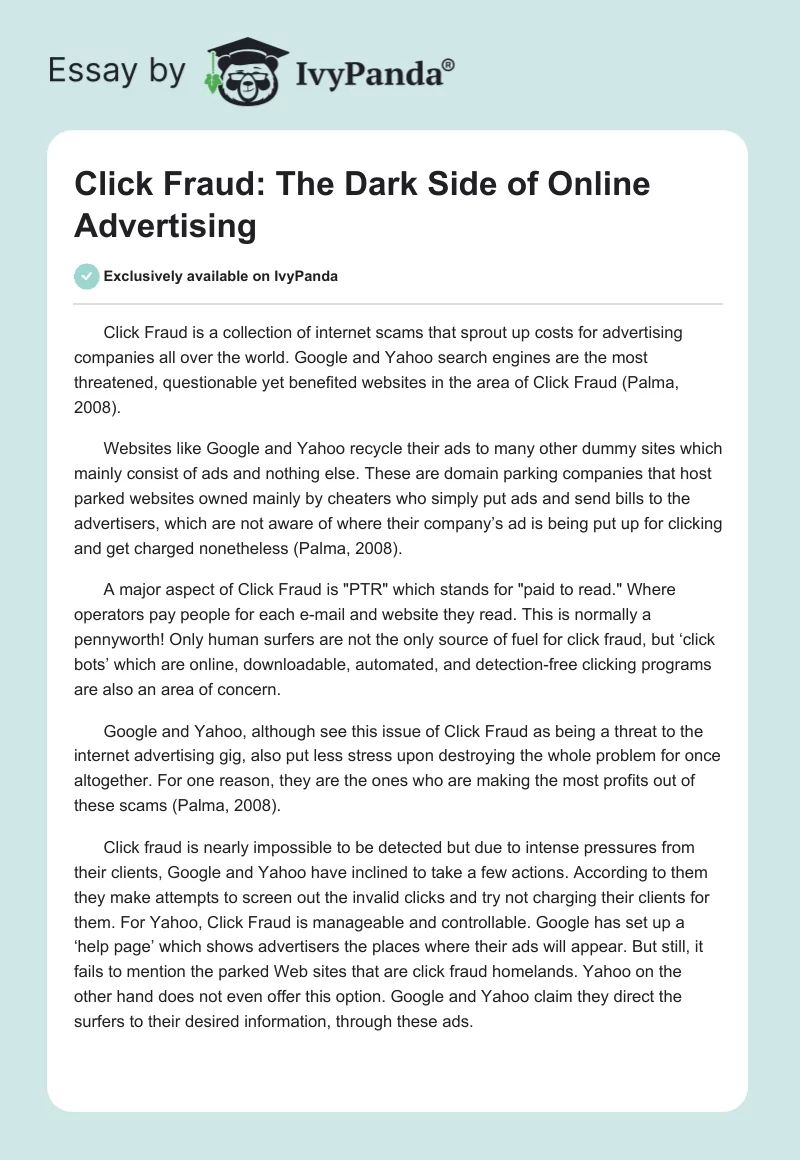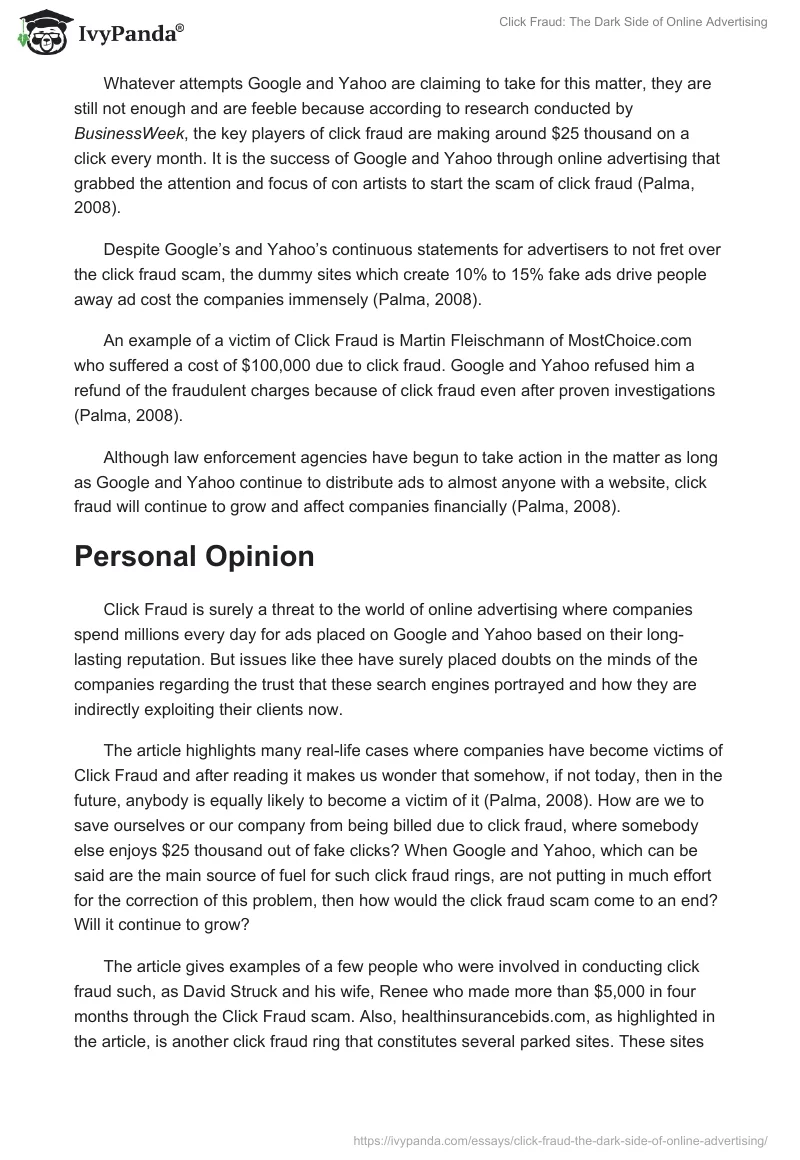Click Fraud is a collection of internet scams that sprout up costs for advertising companies all over the world. Google and Yahoo search engines are the most threatened, questionable yet benefited websites in the area of Click Fraud (Palma, 2008).
Websites like Google and Yahoo recycle their ads to many other dummy sites which mainly consist of ads and nothing else. These are domain parking companies that host parked websites owned mainly by cheaters who simply put ads and send bills to the advertisers, which are not aware of where their company’s ad is being put up for clicking and get charged nonetheless (Palma, 2008).
A major aspect of Click Fraud is “PTR” which stands for “paid to read.” Where operators pay people for each e-mail and website they read. This is normally a pennyworth! Only human surfers are not the only source of fuel for click fraud, but ‘click bots’ which are online, downloadable, automated, and detection-free clicking programs are also an area of concern.
Google and Yahoo, although see this issue of Click Fraud as being a threat to the internet advertising gig, also put less stress upon destroying the whole problem for once altogether. For one reason, they are the ones who are making the most profits out of these scams (Palma, 2008).
Click fraud is nearly impossible to be detected but due to intense pressures from their clients, Google and Yahoo have inclined to take a few actions. According to them they make attempts to screen out the invalid clicks and try not charging their clients for them. For Yahoo, Click Fraud is manageable and controllable. Google has set up a ‘help page’ which shows advertisers the places where their ads will appear. But still, it fails to mention the parked Web sites that are click fraud homelands. Yahoo on the other hand does not even offer this option. Google and Yahoo claim they direct the surfers to their desired information, through these ads.
Whatever attempts Google and Yahoo are claiming to take for this matter, they are still not enough and are feeble because according to research conducted by BusinessWeek, the key players of click fraud are making around $25 thousand on a click every month. It is the success of Google and Yahoo through online advertising that grabbed the attention and focus of con artists to start the scam of click fraud (Palma, 2008).
Despite Google’s and Yahoo’s continuous statements for advertisers to not fret over the click fraud scam, the dummy sites which create 10% to 15% fake ads drive people away ad cost the companies immensely (Palma, 2008).
An example of a victim of Click Fraud is Martin Fleischmann of MostChoice.com who suffered a cost of $100,000 due to click fraud. Google and Yahoo refused him a refund of the fraudulent charges because of click fraud even after proven investigations (Palma, 2008).
Although law enforcement agencies have begun to take action in the matter as long as Google and Yahoo continue to distribute ads to almost anyone with a website, click fraud will continue to grow and affect companies financially (Palma, 2008).
Personal Opinion
Click Fraud is surely a threat to the world of online advertising where companies spend millions every day for ads placed on Google and Yahoo based on their long-lasting reputation. But issues like thee have surely placed doubts on the minds of the companies regarding the trust that these search engines portrayed and how they are indirectly exploiting their clients now.
The article highlights many real-life cases where companies have become victims of Click Fraud and after reading it makes us wonder that somehow, if not today, then in the future, anybody is equally likely to become a victim of it (Palma, 2008). How are we to save ourselves or our company from being billed due to click fraud, where somebody else enjoys $25 thousand out of fake clicks? When Google and Yahoo, which can be said are the main source of fuel for such click fraud rings, are not putting in much effort for the correction of this problem, then how would the click fraud scam come to an end? Will it continue to grow?
The article gives examples of a few people who were involved in conducting click fraud such, as David Struck and his wife, Renee who made more than $5,000 in four months through the Click Fraud scam. Also, healthinsurancebids.com, as highlighted in the article, is another click fraud ring that constitutes several parked sites. These sites are registered to Roland Kiss of Budapest. Kiss has expertise in ‘paid to read’ websites (Palma, 2008).
What the article does not mention is whether these people were charged? And they are doing it so openly as if it is ok to do so. Is it ok? It is thought-provoking how click fraud which is primarily a crime has become so widespread that people are doing it openly without any fear of getting caught. I say, even if it is common, it still isn’t ok!
Although I do not operate a website or have any associations with Google Ads, I can very well understand the caution the whole process requires with regards to avoiding click fraud. There is a need for more investigation in this matter to dig out fraudulent web addresses and dummy sites that are causing this mayhem.
Google and Yahoo need to be more advanced with their screening processes for such websites that exploit their clients. Through my knowledge, I know of click fraud detection software available from Adtrack, which is a non-profit making company through the website: www.adtrackerreviews.com.
Apart from the threat of PTR, another newly spreading is called PTC sites. These are an upgrade of PTR. This is claimed to be Click Fraud free according to many investigators.
Work Cited
Palma, Paul. Annual Editions: Computers in Society 09/10. 15th ed. McGraw Hill, 2008. 14-19.


